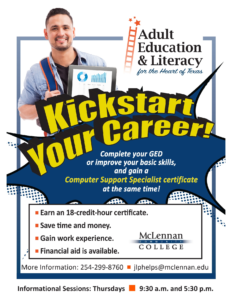By Trey Crumpton
WARNING: I use the term dialogue a lot in this article. So, if you don’t like dialogue, end your pain now and stop reading.
For the next four years, we will tackle a complete renovation of the Harry and Anna Jeanes Discovery Center, part of the Mayborn Museum Complex at Baylor. It’s hard to believe it has been twelve years since we re-opened in our new digs on University Parks Drive. This will be tricky, as many parents in Waco know there are standard “go-to” rooms which are “must-sees” during every visit. We are taking a strategic approach, closing only a few rooms during each renovation phase, and providing other opportunities for engagement to make up for inconvenience. But, never fear! The end result will be an awesome upgrade, and we think it will be worth the wait!
Now, here comes dialogue. When creating engaging exhibits, the separate dialogues of entertainment and education both come into play, and are equally valuable. The visitor relates to an experience to be entertained, and usually to a lesser extent to be educated. Our philosophy of exhibitions includes an attempt to show every visitor, from every background, something outside their understanding, outside what they know. These are experiences that grow all of us, even the staff who work to create them. We want to enrich a child’s and an adult’s life by providing those discovery moments; the spark of the “What if?,” the “Can I build this?,” the “Why can’t I?” This certainly stretches across toddler play and into thought-provoking exhibitions on complicated subject matter. We choose to take intellectual activity as a spiritual discipline.
Engagement with culture gives the museum relevance and value within the public sphere, and may provide a calm place for voices of the under-heard and mis-heard. The Mayborn can use its exhibits, collections, programs, and events to bond together groups of widely varied experience and philosophy.
In order to provide meaningful experiences, there must first be dialogue from community stakeholders. Recently, our outreach efforts have focused on a wide cross-section of community and scholarly input for the discovery room renovations. Advisory panels continue to be useful apparatus to build consensus on ideas and direction for specific exhibits. The range of opinion and reaction within these panels helps us predict what the broader community reaction might be. We build these bridges, as any intelligent organization does, partly out of a selfish desire to head off unforeseen public relations situations, but primarily out of a professional and heartfelt motivation to fulfill the museum’s mission of service. Collaboration is a noble goal in itself, and if the greatest product of our conversations is a resilient bond between the museum and our community, we have all succeeded.
 This fall, we have the special opportunity to host the temporary exhibition, Sacred Journeys, which is produced by The Children’s Museum of Indianapolis and the National Geographic Society. It will focus on the important pilgrimages of five major world religions: Christianity, Islam, Judaism, Hinduism, and Buddhism. These are presented not as apologetics for each religion, but as the experiences—stories (or dialogues)—of five young individuals who make these journeys. Dialogue with local interested groups has enhanced our understanding of possible concerns, and we hope has provided a safe and honest forum toward mutual respect. The goal of exhibitions such as Sacred Journeys is to facilitate dialogue over our shared humanity.
This fall, we have the special opportunity to host the temporary exhibition, Sacred Journeys, which is produced by The Children’s Museum of Indianapolis and the National Geographic Society. It will focus on the important pilgrimages of five major world religions: Christianity, Islam, Judaism, Hinduism, and Buddhism. These are presented not as apologetics for each religion, but as the experiences—stories (or dialogues)—of five young individuals who make these journeys. Dialogue with local interested groups has enhanced our understanding of possible concerns, and we hope has provided a safe and honest forum toward mutual respect. The goal of exhibitions such as Sacred Journeys is to facilitate dialogue over our shared humanity.
We are part of a Christian institution, and people sometimes retain automatic judgements based on that fact—and from widely varying ideologies. These assumptions may or may not be accurate, and dialogue may be sabotaged in infancy because of them. Museum ethics dictate that to maintain the public trust, we must present objective fact as far as we can ascertain it, rather than presenting ideologies directed against certain viewpoints. Generally, if any individual or institution loses credibility in one area, it is difficult to maintain it in others. This space where museum interpretation cannot tread is open for public “facilitated dialogue,” and conversations are in the works to host an inter-faith discussion this fall.
Candid communication and empathy are required if we are to understand which philosophies we share, and which are different. From whatever vantage point or set of values we begin, it takes courage to overcome these assumptions and sit down to a productive conversation. When discussing a museum exhibition on religion, it might be instructive to use Joel Hunter’s term, “elastic orthodoxy.” Without compromising or diluting faith, one can maintain the ability to work with those who do not believe in the same way. In museums, as in life, this respect is the basis for strong partnerships, and our greatest partner is our public.
The process of dialogue pushes us to realize that none of us has all the answers—but if we discover together, we can get closer to them!
 Trey Crumpton is Exhibits Manager for the Mayborn Museum Complex at Baylor University, where he has been on staff for 10 years. He has lived in Waco since 2001, and has two energetic preschoolers who love to discover. His beautiful wife Ashley is an early childhood educator, and together they are proponents of all things educational, enriching and fun. Trey loves family, friends, the outdoors, dark chocolate, good books, pizza, and good film.
Trey Crumpton is Exhibits Manager for the Mayborn Museum Complex at Baylor University, where he has been on staff for 10 years. He has lived in Waco since 2001, and has two energetic preschoolers who love to discover. His beautiful wife Ashley is an early childhood educator, and together they are proponents of all things educational, enriching and fun. Trey loves family, friends, the outdoors, dark chocolate, good books, pizza, and good film.
The Act Locally Waco blog publishes posts with a connection to these aspirations for Waco. If you are interested in writing for the Act Locally Waco Blog, please email [email protected] for more information.
by Lucas Land
When you hear the word “sustainable”, what’s the first city you think of? Portland? Austin? Somewhere in California? Why not Waco?
While Austin installs a food forest and San Diego commits to move to 100% renewable energy by 2025, it feels like Waco is always playing catch up to other cities. We may not have a reputation for being “eco-friendly,” but I am constantly surprised by the things already happening in Waco promoting sustainability. Of course, there is still plenty of work to do, but there are ways for you to get connected and get involved.
Sustainability can be understood as the state in which a system is able to continue indefinitely without depleting the resources on which the system depends. It is obvious by this definition that the fossil fuels on which so much of our civilization depends never will be sustainable. Taking the path away from fossil fuels will be difficult. The biggest barrier obstructing our progress is the idea that we are separate, from each other and from the earth.
We, however, are not separate. We all depend on the Brazos (and Lake Waco) for our water. With a growing local food economy, we can see how the land around us provides food to eat. The device you are currently using to read this connects you to points across the globe. We are in this together, and we are not alone.
What’s Happening?
When I moved to Waco in 2009 to intern at World Hunger Relief, a local organization working on sustainable agriculture here and around the world, there was only a small farmer’s market at the Extraco Events Center. Because of the hard work of some Wacoans, we now have a year-round, weekly market on the river that has thousands of visitors every year, has encouraged and supported our local food economy, and currently features over 30 vendors.
The local Mars factory leads the business community with a strong commitment to sustainability. The plant that produces most of the world’s Skittles also produces much of its energy needs by harnessing methane gas from the landfill, wastewater plant, and waste from local companies, such as Cargill. The Mars plant also hosts an Earth Day event every year to raise awareness about sustainability.
Civically, Waco shows just as much promise. Just this month Mayor Duncan and the city council approved the creation of the Sustainable Resources Practices Advisory Board. The Friends of Peace/Climate group hosts monthly documentaries about climate change, propose changes such as the plastic bag ban, and also plans and implements actions to raise awareness. They have done this work for almost a decade.
For my part, I bike to work and my family makes do with one vehicle. I’ve also worked hard to promote sustainable and edible landscaping in urban yards. I started a small landscaping business called Edible Lawns and I’ve taught classes on raising backyard chickens for MCC Continuing Education.
I feel bad not saying more about Baylor’s Campus Kitchen, Bosque River Coalition, The Center for Reservoir and Aquatic Systems Research at Baylor, Central Texas Audubon Society, Critical Mass Waco, Deb Tolman, The Dwyer Group, Keep Waco Beautiful, Master Naturalists, Master Gardeners, Red Caboose Winery, Urban Gardening Coalition, and many more. These are just a few examples of what’s already happening in Waco.
What Needs to Happen?
It’s also true that we have a long way to go towards achieving a sustainable city. Plans to rebuild the energy plant at Tradinghouse Lake would be a huge step backwards. Plans for the new plant would continue to supply our energy needs from fossil fuels. Instead, we need to work to build energy alternatives to fossil fuels in our community. We need incentives for businesses and citizens to move towards renewable energy.
We need to reduce our dependence on cars for our daily transportation needs. It will take a lot more work before anyone considers Waco “bike-friendly.” Better public transportation will also contribute to decreasing our dependence on cars.
Our lives are still saturated with fossil fuels. They are in everything from medicines, to cosmetics, to fabrics, to toothpaste, to shoes and basketballs. Transitioning away from fossil fuels will require producing more of what we need close to home, finding new (and sometimes old) ways to produce the things we need, and sharing more of the things we don’t use all the time like tools and lawnmowers.
How to Get Involved
A few years ago I realized I knew many people across our city who were interested in sustainability, but many of them didn’t know each other. I started Sustainable Waco to network and connect with more of these people (online and in person). I want to invite you to be part of making Waco more sustainable.
You can meet people on the Sustainable Waco Facebook page, and find organizations and events in town on the Sustainable Waco website. Connect your gifts and passions to what’s already happening. If it’s not happening yet, ask for support and partners to get started and make it happen. Tell me what you’re up to and I’ll add it to the list.
Rather than feeling bad about not being Portland or Austin when it comes to sustainability, let’s recognize the gifts and resources in our own backyard. We can build on the work that many are already doing. If we work together, soon Waco will be among the cities that come to mind when people in Texas and around the country hear the word “sustainable”. What are you waiting for? Let’s go!
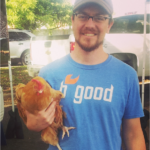 Lucas Land is an eco-theologian, urban farmer, activist, aspiring master naturalist, facilitator, musician, and writer. He is avoiding growing up by constantly learning and trying new things. He also works in Grants Management for Waco ISD. He lives with his wife, three children, flock of chickens, dog, and cat in the Sanger Heights Neighborhood in North Waco.
Lucas Land is an eco-theologian, urban farmer, activist, aspiring master naturalist, facilitator, musician, and writer. He is avoiding growing up by constantly learning and trying new things. He also works in Grants Management for Waco ISD. He lives with his wife, three children, flock of chickens, dog, and cat in the Sanger Heights Neighborhood in North Waco.
The Act Locally Waco blog publishes posts with a connection to these aspirations for Waco. If you are interested in writing for the Act Locally Waco Blog, please email [email protected] for more information.
By Macy Warburton
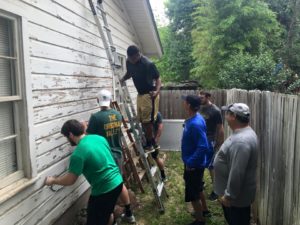 If you were out and about in Waco this past weekend, you may have seen large numbers of Baylor students in the community sporting tools and paint brushes. What was happening, you ask? Steppin’ Out – a day of service Baylor students participate in each semester. Led and organized by the Steppin’ Out Steering Committee comprised fully of students, individuals clean yards, paint houses, and help meet various other needs by coming alongside homeowners and organizations within Waco. This semester almost 2,000 students served at more than 60 locations around our community.
If you were out and about in Waco this past weekend, you may have seen large numbers of Baylor students in the community sporting tools and paint brushes. What was happening, you ask? Steppin’ Out – a day of service Baylor students participate in each semester. Led and organized by the Steppin’ Out Steering Committee comprised fully of students, individuals clean yards, paint houses, and help meet various other needs by coming alongside homeowners and organizations within Waco. This semester almost 2,000 students served at more than 60 locations around our community.
I have had the honor of serving as the advisor for the Steppin’ Out Steering Committee this semester, and I am simply amazed by their work and commitment to the Waco community. These students run the entire program, working with our Baylor community on one end to recruit volunteers and working with our Waco community on the other end to pinpoint potential areas of service. They spend countless hours building relationships with homeowners, raising money to purchase the necessary tools and paint, and coordinating all other logistics. Along with the committee, we see the commitment from those students that choose to serve each and every semester, many of whom return due to the impactful relationships they have formed within the community.
 What can seem like just a “day of service” is truly more than that. Just this past weekend almost 20 house painting sites were postponed due to the rain. Instead of taking the easy way out, most of the students and organizations assigned to those sites have asked to maintain their commitment by completing these paint jobs by the end of the semester. These students have displayed their commitment not to Steppin’ Out, but to the people they are serving.
What can seem like just a “day of service” is truly more than that. Just this past weekend almost 20 house painting sites were postponed due to the rain. Instead of taking the easy way out, most of the students and organizations assigned to those sites have asked to maintain their commitment by completing these paint jobs by the end of the semester. These students have displayed their commitment not to Steppin’ Out, but to the people they are serving.
It is important to note that these connections are not made to be confined within the walls of Steppin’ Out. Our Office of Community Engagement and Service continuously works to connect the Baylor community with the Waco community. We work to showcase service opportunities, promote education and advocacy, and much more. Many of our students are in the community doing great work through mentoring, volunteering, and more, but there is much room for growth. We are dedicated to this growth and committed to empowering our students as residents of Waco.
 People and organizations within the Waco community can make a connection with us at any time. Want to promote your volunteer opportunities on CONNECT, our online service database? Want to plan an educational event with our office? Want to develop a collaborative training for volunteers? We would love to come alongside you in any way possible to help you reach your visions. I personally would love to chat with you about our opportunities for connection. Send an email to [email protected] or give me a call at 254-710-7687 at any time.
People and organizations within the Waco community can make a connection with us at any time. Want to promote your volunteer opportunities on CONNECT, our online service database? Want to plan an educational event with our office? Want to develop a collaborative training for volunteers? We would love to come alongside you in any way possible to help you reach your visions. I personally would love to chat with you about our opportunities for connection. Send an email to [email protected] or give me a call at 254-710-7687 at any time.
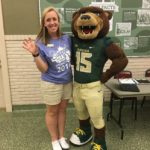 Macy Warburton is the coordinator for community service in the Office of Community Engagement and Service at Baylor University. She loves running, playing guitar, and drinking coffee.
Macy Warburton is the coordinator for community service in the Office of Community Engagement and Service at Baylor University. She loves running, playing guitar, and drinking coffee.
The Act Locally Waco blog publishes posts with a connection to these aspirations for Waco. If you are interested in writing for the Act Locally Waco Blog, please email [email protected] for more information.
By Jenuine Poetess
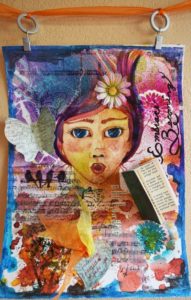 I have the immense joy of working with a professional colleague who is not only a gifted mental health clinician, but also a talented artist—across a number of disciplines. As I joined Enrichment Training and Counseling Solutions we moved into a new suite of offices–a space which has afforded the creation of a therapeutic art studio. In this month’s Arts & Culture Blog, I share with you an interview I did with Salley Schmid, LMFT about her use of art in session with clients.
I have the immense joy of working with a professional colleague who is not only a gifted mental health clinician, but also a talented artist—across a number of disciplines. As I joined Enrichment Training and Counseling Solutions we moved into a new suite of offices–a space which has afforded the creation of a therapeutic art studio. In this month’s Arts & Culture Blog, I share with you an interview I did with Salley Schmid, LMFT about her use of art in session with clients.
Jenuine Poetess: Please share a bit about yourself generally—as an artist, as a therapist, as a person with various roles/identities.
Salley Schmid: I am a child of God, daughter, sister, wife, mother, friend, therapist, student, trainer, business owner, and artist. I guess since I have done three triathlon events, I can say I am a triathlete as well. But that one is hard for me to believe. That would fill a whole different article though so I will leave it at that. I love being outdoors, music, long meaningful conversations, learning, drawing, painting, kayaking, cycling, swimming, the beach the mountains and living life out loud. I once was silenced, but no more.
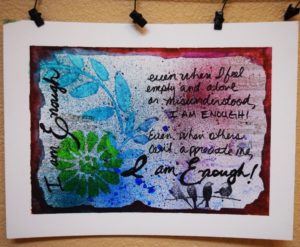 I have not had formal training as an artist. I grew up around constant expressions of creativity from my mother and my three older sisters. My oldest sister studied art formally. One of my greatest lessons in life came from a high school art teacher. Ironically, one of my most painful moments came from the same place. The great lesson was after making a mistake on a watercolor painting. I was painting a face. I dropped a huge blob of red paint in the middle of the face. I asked my instructor for new paper so that I could start over. She refused to let me start over. She said I had to work with it and make it work with the painting. I ended up painting only part of the face and making it look like someone behind a door peeking through the window. I was pretty mad at my teacher for not letting me start over, but in the end this painting was much better, much more interesting. It now had mystery and intrigue and became one of my favorite paintings. The painful experience came from somehow walking away from that class believing that I had no talent based on a single letter on a report card. I let go of art for a long time after that. And I really missed that part of me. To this day, I struggle to make the statement that I am an artist. Never the less; I AM AN ARTIST.
I have not had formal training as an artist. I grew up around constant expressions of creativity from my mother and my three older sisters. My oldest sister studied art formally. One of my greatest lessons in life came from a high school art teacher. Ironically, one of my most painful moments came from the same place. The great lesson was after making a mistake on a watercolor painting. I was painting a face. I dropped a huge blob of red paint in the middle of the face. I asked my instructor for new paper so that I could start over. She refused to let me start over. She said I had to work with it and make it work with the painting. I ended up painting only part of the face and making it look like someone behind a door peeking through the window. I was pretty mad at my teacher for not letting me start over, but in the end this painting was much better, much more interesting. It now had mystery and intrigue and became one of my favorite paintings. The painful experience came from somehow walking away from that class believing that I had no talent based on a single letter on a report card. I let go of art for a long time after that. And I really missed that part of me. To this day, I struggle to make the statement that I am an artist. Never the less; I AM AN ARTIST.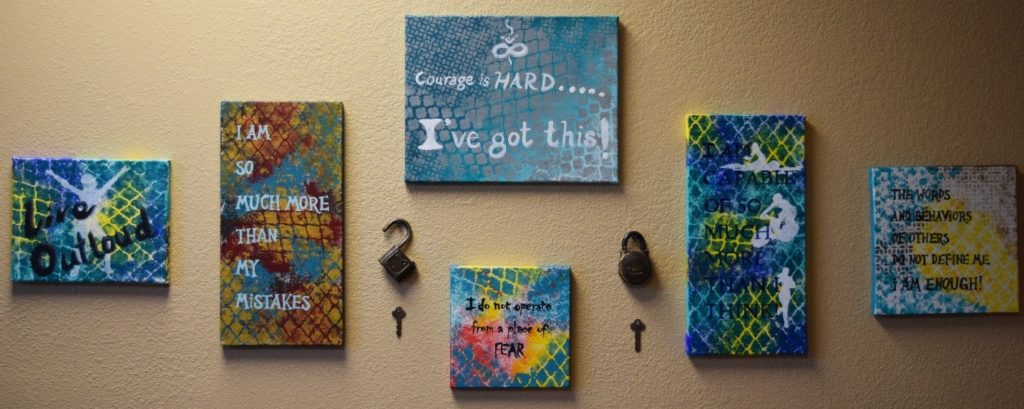
My first degree is a BS in Therapeutic Recreation. Yes, that is a real degree. I love the work I did in that degree. I think it has made me much better as a therapist now because I am not afraid to tap into experiential ways of processing and wrestling with life’s challenges. That’s why and how I began to takes risks with incorporating art and other creative expressive outlets into the therapeutic process. Art has helped many of my clients tap into deep emotions that words could not connect with or give a voice to.
JP: How did you first connect with art? What about art as an expression drew you in?
SS: I remember sewing by hand what my mother called yoyo’s while sitting on the ping pong table in the basement, my mother at the sewing machine and the TV filled with soap operas, often Dark Shadows. That’s my earliest creative memory. From then on, I was creating whenever I could. I created in the kitchen, I would spend hours on the floor sketching. I loved to decorate my room and come up with creative ways to paint an accent wall, which my mother thankfully indulged. I can’t remember my life without art. Art has always tapped into my soul and given life to emotion when words failed. Art has helped me find, recognize and express emotions that I had hidden from myself. Art has brought healing to me. I often see the world in paint strokes, colors and shadows. I catch myself staring at things, people, nature . . . sketching always in my mind, studying the lines, the light and the shadows.
JP: How did you come to integrate creative process with your therapeutic process?
 SS: Perhaps first through the use of art in my own healing process after a difficult emotionally abusive marriage, followed by a volatile divorce. I painted my way through and out of the pain. I found that I loved different mediums for different emotions. Distressing emotions were best expressed in textured thick acrylic, where I preferred watercolor for hope and free spirited forward movement in my healing journey. Oddly, my first divorce painting is acrylic but became an expression of hope contrary to my plan when I began the painting. It’s an abstract expression of what feels like painful brokenness but is actually the pathway to the light and hope and living vibrantly.
SS: Perhaps first through the use of art in my own healing process after a difficult emotionally abusive marriage, followed by a volatile divorce. I painted my way through and out of the pain. I found that I loved different mediums for different emotions. Distressing emotions were best expressed in textured thick acrylic, where I preferred watercolor for hope and free spirited forward movement in my healing journey. Oddly, my first divorce painting is acrylic but became an expression of hope contrary to my plan when I began the painting. It’s an abstract expression of what feels like painful brokenness but is actually the pathway to the light and hope and living vibrantly.
 I was convinced when I began private practice that art was to be a part of how I worked with people, but I was afraid to introduce it initially. Gradually one person at a time, one step at a time, I began to incorporate art. One of my first clients was a big burly man who was at a loss for words. I handed him a pencil and a sketch pad and told him to put the pencil to the paper and see what came out. It was profound and his insights were pivotal. Each time I introduce art to the therapeutic process I am affirmed in this work and the therapeutic relevance and power of visual creative expression.
I was convinced when I began private practice that art was to be a part of how I worked with people, but I was afraid to introduce it initially. Gradually one person at a time, one step at a time, I began to incorporate art. One of my first clients was a big burly man who was at a loss for words. I handed him a pencil and a sketch pad and told him to put the pencil to the paper and see what came out. It was profound and his insights were pivotal. Each time I introduce art to the therapeutic process I am affirmed in this work and the therapeutic relevance and power of visual creative expression.
JP: What do you see as the value of incorporating art into the therapy journey?
SS: Because art has a way of giving a voice to experiences that occurred before the age of language and because the soul is more emotion than cognitive thought, art is the best matched medium for many to connect healing to pain.
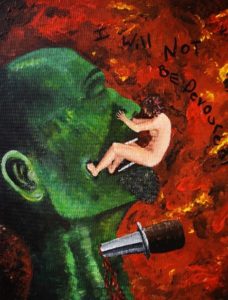 JP: What are some of the most significant moments/experiences you’ve had with art?
JP: What are some of the most significant moments/experiences you’ve had with art?
SS: The experiences I shared earlier from high school for sure. My “divorce” paintings as I call them were significant both in the power of expression, clarity and healing as well as reclaiming a lost part of my soul. Those were very healing and the first time I let myself express myself through art in more years than I can count. The artist in me was one thing stomped out by the emotionally abusive relationship. I think because I became so numb and empty. Now, giving others an emotionally safe place, space and opportunity to find healing through art, brings me joy and affirmation. I  personally feel most full after sessions where a client gave expression, gained insight or found a path toward healing through art in therapy. Additionally, I find I do my most emotionally honest work and healing through art. My head swims with ideas.
personally feel most full after sessions where a client gave expression, gained insight or found a path toward healing through art in therapy. Additionally, I find I do my most emotionally honest work and healing through art. My head swims with ideas.
JP: What are your favorite mediums to play with?
SS: Stained glass is actually one of my favorite mediums. However, I have not done stained glass since my daughters were born 18 years ago. The mood of what I am painting makes a big difference in what medium I like. If I had to pick, I would say water color.
JP: Would you share about a project you are working on or plan to work on in the future?
SS: I have recently begun working on creating jewelry with therapeutic and inspirational meaning. I am stamping words into metal, framing the metal with solder, and adding elements that capture mood, and meaning. I hope to master this in a way that I can then engage my clients in creating their own pieces with what I call anchor words. So for example, an anchor  word for me is PEACE. I use this word by saying in times of distress “what would I be doing differently right now if I were acting from a place of peace”. The jewelry is a beautiful reminder to use the anchor word.
word for me is PEACE. I use this word by saying in times of distress “what would I be doing differently right now if I were acting from a place of peace”. The jewelry is a beautiful reminder to use the anchor word.
I have a list of ideas that is constantly growing. Images come to me in sessions from what client say sometimes. When that happens I jot down a quick note. Sometimes it becomes an assignment for the client, it inspires a page in the art journal I hope to publish. Sometimes it becomes a piece that I create and give to the client.
JP: What is something you wish more people knew about with regards to art and the therapeutic process?
SS: The therapist does not always have to know the meaning in the client’s work. We do not have to put words to every single thing. Words matter, meaning is important. As long as the art touches the client’s soul, has meaning for them, inspires them, creates a needed shift for them, it is worth doing. It is a wise investment of self, both the self of the therapist and the self of the client.
JP: What do you love about Waco?
SS: When I first arrived in Waco, I thought, “Oh my gosh, where have I landed?” In short order, however, I learned to love the community. The small town feel, the entrepreneurial spirit, the friends, the ample opportunities to be involved in activities of all kinds from athletics, to art to food, to music, the list goes on. I can’t see myself living anywhere else now. I think we have such a gift in Cameron Park, Woodway Park, downtown. I love to kayak and cycle, we have so many places and opportunities to engage in outdoor activity here. We are a generous community too. I see so much giving going on. We are a community that creates opportunity, growth, and we are learning to embrace diversity. I love my Wacotown!
 JP: What would you like to see more of in/around Waco?
JP: What would you like to see more of in/around Waco?
SS: More art of course. I am super excited about the efforts being made to recognize Waco as a cultural arts hub. I am about to launch my children into adulthood. Scary, but also brings opportunities to get involved in things that I held back from in order to be home more. I would love to see more draw to our community from surrounding areas and even out of state around the arts. Opportunities to see art as it’s created, to buy local art, to hear local art – music and spoken. I would love to see Waco on the map as a place for great food, music, art and opportunities to have a great day, great evening, great weekend, both indoors and outdoors.
JP: Anything else on your heart to share?
SS: I hope this inspires people to get involved in Waco, put some color on paper, engage in expressing themselves, and both invest in and indulge in the opportunities that abound here.
*All photos are of Salley Schmid’s original artwork, shared with permission for this blog. Please do not copy or use without permission of the artist.
 Jenuine Poetess is an artist, visionary, and community organizer. In 2010, she founded In the Words of Womyn (ITWOW), an international, grass-roots, written and spoken-word arts project with chapters throughout Los Angeles, CA; Waco, TX; and Lebanon. Jenuine is the founder of Waco Poets Society and co-founder of the Central Texas Artist Collective. She writes, organizes, and creates rooted in the fierce conviction that holding intentional space, access, and opportunity for all people to foster their creative health is a matter of justice and is a vital asset to the sustainable thriving of communities. She currently lives and poems in Central Texas where she enjoys finding new ways to disrupt the homeostasis of her city. You can contact her at: j[email protected].
Jenuine Poetess is an artist, visionary, and community organizer. In 2010, she founded In the Words of Womyn (ITWOW), an international, grass-roots, written and spoken-word arts project with chapters throughout Los Angeles, CA; Waco, TX; and Lebanon. Jenuine is the founder of Waco Poets Society and co-founder of the Central Texas Artist Collective. She writes, organizes, and creates rooted in the fierce conviction that holding intentional space, access, and opportunity for all people to foster their creative health is a matter of justice and is a vital asset to the sustainable thriving of communities. She currently lives and poems in Central Texas where she enjoys finding new ways to disrupt the homeostasis of her city. You can contact her at: j[email protected].
The Act Locally Waco blog publishes posts with a connection to these aspirations for Waco. If you are interested in writing for the Act Locally Waco Blog, please email [email protected] for more information.
By Fred Hills
Inquiry. Research. The ability to come up with questions and actively, rigorously pursue answers to those questions is at the heart of education. It is the key to life-long learning, to new inventions, to solving problems, and to improving the way we live and work together in our community and in our world. Just as important as being able to find answers is the ability to communicate findings clearly so that they can be of use to the wider world. At McLennan Community College, students practice inquiry and research throughout the academic year. We would like to invite you to hear about some of their findings and to see for yourself how well they communicate what they have learned in their explorations.
 Every fall and spring semester McLennan Community College conducts an event to showcase student research projects. The event, called Scholar Day, is an opportunity for students from across campus to share the results of their inquiry and the impact it has on our community. Participating students come from a wide variety of disciplines including Biology, Chemistry, Engineering, Management, Marketing, Music, and Respiratory Care, among others.
Every fall and spring semester McLennan Community College conducts an event to showcase student research projects. The event, called Scholar Day, is an opportunity for students from across campus to share the results of their inquiry and the impact it has on our community. Participating students come from a wide variety of disciplines including Biology, Chemistry, Engineering, Management, Marketing, Music, and Respiratory Care, among others.
Research projects at MCC are student initiated with faculty helping guide them through their exploratory work. Students then present findings through scholarly presentations, exhibits, poster boards, art work, music, and prototypes with the campus and the community. Research not only prepares the student for their chosen career path, but will help them if they choose to further their education beyond MCC.
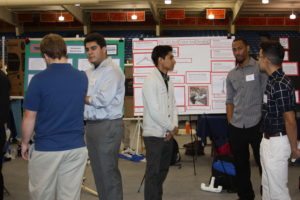 This semester’s program includes over 20 presentations that address timely topics affecting our world today, for example undocumented students in higher education, using vitamin C to fight cancer, and the effects of violent video games on gamers. Several presentations tackle medical topics, like adult respiratory distress syndrome, interstitial lung disease, and LSVT BIG and VOICE therapy on Parkinson’s disease. Scholar Day will also include a few unique items, such as sculptures, painting, and pottery from the Fine Arts department, and inventions and “Rube Goldberg” machines from the Engineering department. Last fall saw over 300 students participate, a number that continues to climb each semester.
This semester’s program includes over 20 presentations that address timely topics affecting our world today, for example undocumented students in higher education, using vitamin C to fight cancer, and the effects of violent video games on gamers. Several presentations tackle medical topics, like adult respiratory distress syndrome, interstitial lung disease, and LSVT BIG and VOICE therapy on Parkinson’s disease. Scholar Day will also include a few unique items, such as sculptures, painting, and pottery from the Fine Arts department, and inventions and “Rube Goldberg” machines from the Engineering department. Last fall saw over 300 students participate, a number that continues to climb each semester.
Come join our students in the excitement of academic inquiry and exploration! If you would like to attend MCC’s Scholar Day, it will be at Highland Gym on Friday, April 22 from 10 to 1 PM. All students and community members are invited to join us. If you need any more information, please contact Dr. Staci Taylor at [email protected].
 Dr. Fred Hills is the current president of the HOT P-20 and Dean of Arts, Science and Business at McLennan Community College. He has worked and lived in the Waco community for over 20 years and has served on the HOT P20 for the last four years.
Dr. Fred Hills is the current president of the HOT P-20 and Dean of Arts, Science and Business at McLennan Community College. He has worked and lived in the Waco community for over 20 years and has served on the HOT P20 for the last four years.
The Act Locally Waco blog publishes posts with a connection to these aspirations for Waco. If you are interested in writing for the Act Locally Waco Blog, please email [email protected] for more information.
by Kristen Bulgrien
I live in Sanger Heights, and I love it. I moved to Waco three years ago as a graduate student at Baylor, and was pretty clueless about where to find housing in this town. Thankfully I had a roommate-to-be who did some great legwork for us (literally, she was in Waco, driving and walking around to different places while we communicated over email and skype), and we found ourselves in a great little house right in the middle of Sanger Heights. Three years later, we have yet to leave.
So I’d like to dedicate this post to Sanger Heights, and all the things about it that are dear to me. I hope it will cause you to reflect on all the things you love about your little corner of town, and that it might inspire you to pay us a visit here in Sanger Heights.
Let’s start at an obvious place: the food. You can grab a gyro at D’s Mediterranean or some really delicious pancakes at World Cup Café. But you probably already knew that. My favorite little gem that you might not know about is the Paleteria La Nueva Michoacana at 1201 N. 25th. From popsicles to ice cream to horchata to strawberries and cream, this little ice cream shop has something for everyone. Bring cash for your treats, and don’t worry – you can order in English or Spanish.
The next thing is a place I admittedly have a vested interest in – it’s my church, Calvary Baptist, at 18th and Bosque. We’d love it if you joined us on a Sunday morning, but you can also plant veggies in the community garden, get your groove on at zumba (Tuesdays/Thursdays, 7 pm, $2), or sell your wares at our Community Yard Sale (next one is April 23).
Sanger Heights is also home to some great organizations doing great work. Mission Waco and Waco Community Development are full of people who love their community and are doing great work on its behalf. Building affordable homes, mentoring kids, providing jobs, even opening grocery stores and eradicating food deserts – these are just a few of the things they do.
Lastly, if you’ve never experienced Halloween on Colcord…well…you’ve never truly done Halloween. Where I grew up, if you wanted to trick-or-treat, you walked up front steps, knocked on doors, and waited patiently for the residents to come to the door with a candy bowl. That’s not how this works. A section of the street gets closed off to motorists, and it is a heyday of kids, costumes, hot dogs, and candy. If you’re handing out candy on Colcord, don’t even think about going inside your house and waiting for kids to come, because you will never close your door. You might as well don a costume, grab your candy, and gird up your loins for the steady stream of trick-or-treaters on parade through your neighborhood. It is crazy, and it is so much fun.
So, there you have it, a quick ode to Sanger Heights. It is not at all comprehensive – there is so much more to love about this place! But I hope it brings you to our neck of the woods sooner rather than later. I hope it also gets you thinking – what is great about your neighborhood? What are the hidden gems? How can you share them with someone who may not know about them? I hope you take some time today to revel in this little Waco-town we call home. It’s a pretty beautiful place.
 Kristen Bulgrien is a proud Pennsylvanian who can’t decide how she feels about Texas as a whole, but really, really loves Waco. She moved to Waco in 2013 to pursue a Master’s Degree in social work and is now the Director of Community Partnerships at Helping Hands Ministry in Belton, Texas. When she’s not working, you can probably find her at the farmer’s market, the dog park, or Lula Jane’s.
Kristen Bulgrien is a proud Pennsylvanian who can’t decide how she feels about Texas as a whole, but really, really loves Waco. She moved to Waco in 2013 to pursue a Master’s Degree in social work and is now the Director of Community Partnerships at Helping Hands Ministry in Belton, Texas. When she’s not working, you can probably find her at the farmer’s market, the dog park, or Lula Jane’s.
The Act Locally Waco blog publishes posts with a connection to these aspirations for Waco. If you are interested in writing for the Act Locally Waco Blog, please email [email protected] for more information.
By Christina Helmick
Recently, we’ve been getting asked how people can become involved in the Prosper Waco initiative if they can’t attend meetings or meetings aren’t their thing. That’s a good question. We tend to focus on the many meetings that occur within the Prosper Waco initiative, sometimes we don’t communicate clearly enough that there are a plethora of ways to become involved—from subscribing to our newsletter to volunteering your time to help prepare community members to become “job ready.”
Below are five specific opportunities for you to choose to become engaged in the Prosper Waco initiative. These of course are not all of the ways, but just a few to get started.
 Engage the community: Community engagement is a two-way conversation! If you are a part of an organization in town, connect with the Prosper Waco Community Engagement Council to learn how the Prosper Waco initiative aligns with your organization. If you are a community member and you want to join the conversation about the Prosper Waco initiative, host or attend a house meeting with the Community Engagement Council. A house meeting doesn’t have to be at your house—it can be anywhere!
Engage the community: Community engagement is a two-way conversation! If you are a part of an organization in town, connect with the Prosper Waco Community Engagement Council to learn how the Prosper Waco initiative aligns with your organization. If you are a community member and you want to join the conversation about the Prosper Waco initiative, host or attend a house meeting with the Community Engagement Council. A house meeting doesn’t have to be at your house—it can be anywhere!
 Become a mentor: The Mentor Coalition is comprised of various organizations in our community who provide mentoring to Waco youth. There are many different ways to mentor in our community. Check out the list! You may find the perfect match for your availability, your interests and the age person you would like to mentor. LEAD, Communities in Schools and Big Brothers Big Sisters are just a few of the organizations in the coalition.
Become a mentor: The Mentor Coalition is comprised of various organizations in our community who provide mentoring to Waco youth. There are many different ways to mentor in our community. Check out the list! You may find the perfect match for your availability, your interests and the age person you would like to mentor. LEAD, Communities in Schools and Big Brothers Big Sisters are just a few of the organizations in the coalition.
 Support job readiness programs: In our community, we have many organizations working hard to help Waco residents acquire the skills necessary to get and keep a job. Examples of these organizations include HOT Goodwill Industries, Christian Men’s Job Corps, Christian Women’s Job Corp and the newly created Esther’s Closet.
Support job readiness programs: In our community, we have many organizations working hard to help Waco residents acquire the skills necessary to get and keep a job. Examples of these organizations include HOT Goodwill Industries, Christian Men’s Job Corps, Christian Women’s Job Corp and the newly created Esther’s Closet.
 Subscribe to our newsletter: Subscribing to the Prosper Waco newsletter will ensure you are kept abreast of the collaborative efforts that are ongoing in our community. The newsletters arrive on the first Monday of every month. Also, follow us on our Facebook and Twitter pages to receive daily updates on the initiative!
Subscribe to our newsletter: Subscribing to the Prosper Waco newsletter will ensure you are kept abreast of the collaborative efforts that are ongoing in our community. The newsletters arrive on the first Monday of every month. Also, follow us on our Facebook and Twitter pages to receive daily updates on the initiative!
 Of course if you DO want to Attend a meeting you are certainly invited! At either the Steering Committee level or the Working Group level, you can join the ongoing collaborative conversations about strategies and projects that will help address the goals of the initiative. Check the “Events” tab on our website for meeting times, dates and locations.
Of course if you DO want to Attend a meeting you are certainly invited! At either the Steering Committee level or the Working Group level, you can join the ongoing collaborative conversations about strategies and projects that will help address the goals of the initiative. Check the “Events” tab on our website for meeting times, dates and locations.
As I mentioned before, these are just a few ways to get involved in the Prosper Waco initiative. If you have any interest in these opportunities, or want to learn more about them, send me an email and I’d be happy to connect you.
Getting involved with one or more of the aforementioned ways will directly contribute to moving the initiative forward. Our community is working hard to collectively improve the education, health and financial security of each person in our community. There isn’t a silver bullet to alleviating poverty in our community, but with your help, positive change not only can, but will, happen in our community.
 Christina Helmick is the director of communication at Prosper Waco. She is a recent graduate of Baylor University with a BA in Journalism, Public Relations & New Media. Originally she is from Washington, D.C., but has stayed in Waco post-graduation. She is an active mentor at J.H. Hines Elementary School, enjoys spending time with her family and watching Baylor football. Sic ’em Bears!
Christina Helmick is the director of communication at Prosper Waco. She is a recent graduate of Baylor University with a BA in Journalism, Public Relations & New Media. Originally she is from Washington, D.C., but has stayed in Waco post-graduation. She is an active mentor at J.H. Hines Elementary School, enjoys spending time with her family and watching Baylor football. Sic ’em Bears!
The Act Locally Waco blog publishes posts with a connection to these aspirations for Waco. If you are interested in writing for the Act Locally Waco Blog, please email [email protected] for more information.
(Note: This post is part of an on-going series on financial literacy. Two of the goals of Prosper Waco have to do with accumulating wealth: (1) Reduce the percentage of Waco-area households living without three months’ worth of savings if they were not able to work. (2) More than 50 percent of Waco households will have a net worth above $15,000. Our hope is that this series will help move our community towards accomplishing these goals both by sharing information about some of the challenges, complexities and practicalities of managing finances. For other posts in this series, click here: Financial Freedom. — ABT)
By Phil Oliver
Payday and Title Loans
As I shared in my last blog, I have spent many hours talking to individuals and households about honestly addressing their financial goals based on their money flow IN and the flow OUT. In my Financial Coaching, I am finding more and more cases where the short-term allure and convenience of quick (expensive) loans ended up becoming a major source of debt and despair. The complete cycle is more devastating as the flow slows. Medical bills or medicine, sickness or even car repairs, all become major setbacks in any household that basically operates from paycheck to paycheck. This is where many of the financially vulnerable turn to the predatory loan network.
Payday Loans and Title Loans are short-term (usually two week) contracts that require an upfront fee that must be paid back IN FULL in two weeks. The lenders are very willing to arrange for the “convenience” of a direct withdrawal from the consumer’s checking or debit account on payday (That’s why they are called “Payday Loans.”) More often than not, this arrangement results in additional fees and frustrations as the money needed to pay IN FULL is not available two weeks later. To make matters worse, consumers are sometimes also hit with insufficient funds or overdraft fees from their banks on top of the fees already paid for the loan. The larger the loan, the less likely the customer will be able to pay it off in the short term. When that happens, the payday lender often encourages the borrower to start another short term loan with additional fees! Most who borrow, WON’T have the money to pay off the loan in two weeks when it is due, and the cycle develops into devastating debt where eventually payments never chip into the principle at all, and interest mounts exponentially. In the case of an Auto Title loan, the period could be a month, but then thousands of dollars will be due in 30 days. In my coaching meetings, I have found this happening across the city in alarming frequency.
Since my last blog, the City of Waco has passed a Payday Lending ordinance which will go into effect on Sept. 1. This is AWESOME news for consumers in crisis! Now the lending institutions will be held to a reasonable standard of high interest and number of renewals of the loan. They will also be tasked with making sure the loan is not a crippling percentage of the customer’s take home pay. There will be grievance procedures in place for residents to file when lending institutions don’t follow the ordinance.
For more information on this important topic, I HIGHLY recommend contacting The Waco Citizens for Responsible Lending. And keep an eye out for an upcoming “Predatory Lending Training and Update. ” This session will include roundtable discussions concerning predatory lending updates at the federal, state, and local level as well as steps to get involved in your community. Special guest speakers will include Ann Baddour, Director of the Fair Financial Services Project at Texas Appleseed as well as staff from the City of Waco. For more information about Waco Citizens for Responsible Lending, or to get on the list to receive information about the “update” when it is scheduled, please contact Meilana Charles at 254-757-5180 email [email protected] or Tiffany Fry at 254-753-7337 email [email protected]
Student/College Debt
My biggest shift in the last few years with all those I talk with is to emphasize a common investment phrase…. “Return On Investment (ROI).” In regard to a college education, I highly recommend most high school students attend MCC or TSTC to start their studies for ANY degree or certification. These institutions provide a seamless path to job security through an associate’s degree or 4- year college by transfer or at MCC under the University Center opportunity. This combined with dual-credit classes in high school can allow residents to fully enter the job market or an undergraduate degree much more rapidly and with minimal debt.
It is not unusual now for graduates to build up a $40-60,000 student debt while earning an undergraduate degree. This often means up to 20-30% of their take-home pay is committed for long-term debt repayment. This is a huge issue especially when combined with housing costs which can require an additional 40-50% of take home pay. If you add that up, it means that there is only 20-40% left for ALL other living expenses!!
This is where the concept of Return on Investment (ROI) becomes so important. It is financially smart to think carefully about the ROI when planning for college and career. Of course it’s important to consider passion, talents and general interest – adding some consideration of average starting salaries and job availabilities rounds out a healthy equation for financial freedom. In most cases, there are many choices for career paths that are possible that use similar skill sets and training. Most college advisors and high school counselors can offer information for future job salaries, demand data, and trends.
Another consideration to reduce college debt, is the ability to transfer as many credits as possible from the community college. One of the best opportunities here in our area is the MCC University Center program. It allows residents to dually enroll in MCC and a partnering 4-year University while staying in Waco and paying much reduced hourly tuition. It also guarantees the acceptance of credits earned at MCC and puts NO LIMIT on the cumulative number of transfer hours!! Considering that most 4-yr Universities will only allow up to 60 hours to transfer toward a degree, having no limit for transfer hours with partnering Universities could allow any student to actually transfer in as a senior!! This is a HUGE consideration when it comes to debt!
To find out more of about this unique program go to http://uc.mclennan.edu.
We are blessed to have some great resources in our Waco community for growing financially healthy. Our area is also fairly unique in the amount of networking and collaboration being practiced, especially through the new and expanding Prosper Waco initiative. I have been actively involved in this amazing collective and see the growing influence and investment they are creating for our community. Please check out their website and resources at prosperwaco.org, as well as the recommended FREE, foundational curriculum adopted by Prosper Waco for financial training from the Dallas Federal Reserve Bank called “Building Wealth”. That material is available for a FREE download at https://www.dallasfed.org/assets/documents/cd/wealth/wealth.pdf
In my next blog, we’ll look at the 3 main financial ways that deficits in a monthly flow can be addressed and brought into balance. If you have any questions, please feel free to e-mail me directly: [email protected]
 Phil Oliver is a retired educator. He is an independent Financial Coach, active mentor, and community activist. He has spent the last 8 years empowering individuals and families to take charge of their finances through his FLOW system. He is active in many community efforts to grow financial literacy and responsibility including Prosper Waco and Citizens for Responsible Lending. He consults with many local organizations to teach and inspire their efforts to empower clients in personal finances. You can contact him at: [email protected]
Phil Oliver is a retired educator. He is an independent Financial Coach, active mentor, and community activist. He has spent the last 8 years empowering individuals and families to take charge of their finances through his FLOW system. He is active in many community efforts to grow financial literacy and responsibility including Prosper Waco and Citizens for Responsible Lending. He consults with many local organizations to teach and inspire their efforts to empower clients in personal finances. You can contact him at: [email protected]
By Deshauna Hollie
Waco is home and the experience of living here is like no other. I am currently a student studying education, Curriculum and Instruction. I’ve been a student before, lots of times in fact. I love learning, I love the process of learning, and I also love sharing what I have learned. Yet it took a long time before I realized that I should probably consider teaching. Although the name “Curriculum and Instruction” does little to suggest the artistic and philosophical nature of that field of education, it is indeed a creative and innovative field with a focus on 21st century learning and education. Curriculum and Instruction deals with the questions of: How we learn and Why we learn? It uses the answers those question to help determine the best ways to educate students for success, in a constantly evolving world.
One of the most fascinating insights that I have come across is that the biggest factors that indicate a student will achieve and be successful have nothing to do with how well a student does on standardized testing, their socio-economic class, English language ability, learning difference or even their ethnicity. I think that we all are aware that these things are in no way indicative of a child’s intelligence. Along with access to high quality curriculum, and parent and community support — having educators and an education system that believes in them is one of the biggest indicators that students will succeed and achieve.
That’s what I experienced during most of my time as a student in Waco ISD many years ago. It was so influential that it inspired me to write an ode to my favorite school district. Here goes:
My ode to Waco ISD, the only school district I have ever known
To second grade teachers who read to us ever day after lunch
To high school English teachers who made sure we could write research papers
without using “to be” verbs, but who also introduced us to mock weddings, Charles Dickens…
My ode to biology model cells,
My ode to South Waco Elementary and the Apple Core Brigade…
My ode to the great and mighty G.W. Carver Academy where
We knew not what a text book was, but Odysseys kept us engaged in
Learning like no other…
My ode to learning that taught us
Fun words like “metamorphosis” in the forms of optical illusions and dystopia lit…
My ode to block schedules that allowed
Countless students the prestige of early graduation
So that they may forever be admired for their
Advanced Intelligence
My ode to the innovation of a district
That constantly embraces change
21st century learning always on the forefront of it’s mind…
My ode to Waco ISD
Where teachers, parents, community members and administrators alike
Are always succeeding…
 DeShauna Hollie is currently working on Master’s of Arts in Curriculum and Instruction at Greenville College. She is an aspiring teacher and hops farmer. She grew up in Waco and is happy to have returned after living in the Midwest and on the East Coast for awhile.
DeShauna Hollie is currently working on Master’s of Arts in Curriculum and Instruction at Greenville College. She is an aspiring teacher and hops farmer. She grew up in Waco and is happy to have returned after living in the Midwest and on the East Coast for awhile.
The Act Locally Waco blog publishes posts with a connection to these aspirations for Waco. If you are interested in writing for the Act Locally Waco Blog, please email [email protected] for more information.
By Janet Phelps
It can take years for a student to get a GED and finish college. Take, Patty*, for example, who started studying for her GED® in 2014 after dropping out of the 10th grade many years earlier because of a tough situation at home.
Patty completed her GED® just eight months later but continued to work minimum wage factory jobs to support her kids as a single mom.
Last fall, Patty took a CNA class and got a full-time job. She leveraged her newfound stability to take a FastTrack to College class, and then started classes toward her nursing degree at McLennan Community College this spring.
That should be the happy ending to Patty’s story— but it’s not.
She still has to complete her remedial class requirements at MCC while working full-time and struggling to make ends meet. She’s years away from that salaried job she desperately needs.
The length of time it takes people in Patty’s situation to first attain a GED, then complete remedial classes (which don’t typically count toward a degree), and THEN complete classes for a degree is often just too much. Many students drop out along the way. For many, the path is too long to be practical – too many things can go wrong along the way.
MCC is starting a program this spring through a grant from the Higher Education Coordinating Board to help students like Patty achieve their goals. This new Career Pathway option will allow students who dropped out of high school, or who need academic helps to be successful in college, to begin earning college credit more quickly.
Classes begin in May for the first pathway which will result in a Computer Support Specialist Certificate.
The program is designed for students to finish six courses (18 credit hours) and complete their GEDs® in two semesters (Summer and Fall) —bypassing the remedial courses that most students have to take when they start at MCC. Participating students will also get the chance to work toward achieving a work readiness certificate during the class.
Students will be able to go to work immediately when the courses finish in December, and the 18 hours of college credit they earn will also give them a good start toward earning a one or two-year degree in one of five areas at MCC: Computer Information Systems and Applications, Computer Applications, Paralegal, Administrative Assistant and Medical Office Assistant.
MCC’s Adult Education & Literacy Department also plans to partner with Communities in Schools (CIS) to provide paid work experience for students in this program who meet CIS’s eligibility requirements.
MCC is seeking to enroll 15 students without a GED® or high school diploma into this program. If qualified and accepted, MCC will pay for a student’s credit classes until the student demonstrates the success that’s required to qualify for federal financial aid (See: Ability to Benefit). The program is also open to students who have a high school diploma but who need academic remediation or English language help in college. Students who enroll will get academic and social support plus financial help with textbooks and supplies in addition to free tuition at MCC and free GED education.
The Computer Support Specialist certificate is part of the goal of MCC’s Adult Education & Literacy Department to boost the academic and career skills that low-income adults need to get ahead.
Please help us get the word out about this opportunity. To learn more, feel free to contact me. My email is [email protected]. Or, you can call 254-299-8760 or come to an informational session on Thursdays at 9:30 a.m. or 5:30 p.m. on MCC campus.
Computer Support Specialist Certificate Career Pathway
May – December 2016
Career Pathway Informational Sessions
Thursdays at 9:30 a.m. and 5:30 p.m.
Room E224, Community Services Center
McLennan Community College
For more information Contact Janet Phelps: [email protected]
 Janet Phelps is the Transition Specialist for Adult Education and Literacy for the Heart of Texas at McLennan Community College. She loves helping students, reading, and running at Cameron Park.
Janet Phelps is the Transition Specialist for Adult Education and Literacy for the Heart of Texas at McLennan Community College. She loves helping students, reading, and running at Cameron Park.
The Act Locally Waco blog publishes posts with a connection to these aspirations for Waco. If you are interested in writing for the Act Locally Waco Blog, please email [email protected] for more information.
*Patty is not the student’s real name. We used a pseudonym to protect this student’s privacy.

